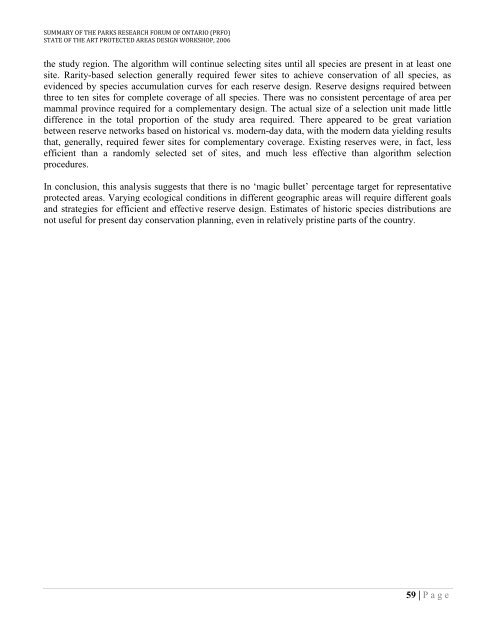Top-Down vs. Bottom Up: Working Towards Consensus ... - CASIOPA
Top-Down vs. Bottom Up: Working Towards Consensus ... - CASIOPA
Top-Down vs. Bottom Up: Working Towards Consensus ... - CASIOPA
- No tags were found...
You also want an ePaper? Increase the reach of your titles
YUMPU automatically turns print PDFs into web optimized ePapers that Google loves.
SUMMARY OF THE PARKS RESEARCH FORUM OF ONTARIO (PRFO)STATE OF THE ART PROTECTED AREAS DESIGN WORKSHOP, 2006the study region. The algorithm will continue selecting sites until all species are present in at least onesite. Rarity-based selection generally required fewer sites to achieve conservation of all species, asevidenced by species accumulation curves for each reserve design. Reserve designs required betweenthree to ten sites for complete coverage of all species. There was no consistent percentage of area permammal province required for a complementary design. The actual size of a selection unit made littledifference in the total proportion of the study area required. There appeared to be great variationbetween reserve networks based on historical <strong>vs</strong>. modern-day data, with the modern data yielding resultsthat, generally, required fewer sites for complementary coverage. Existing reserves were, in fact, lessefficient than a randomly selected set of sites, and much less effective than algorithm selectionprocedures.In conclusion, this analysis suggests that there is no „magic bullet‟ percentage target for representativeprotected areas. Varying ecological conditions in different geographic areas will require different goalsand strategies for efficient and effective reserve design. Estimates of historic species distributions arenot useful for present day conservation planning, even in relatively pristine parts of the country.59 | P a g e


